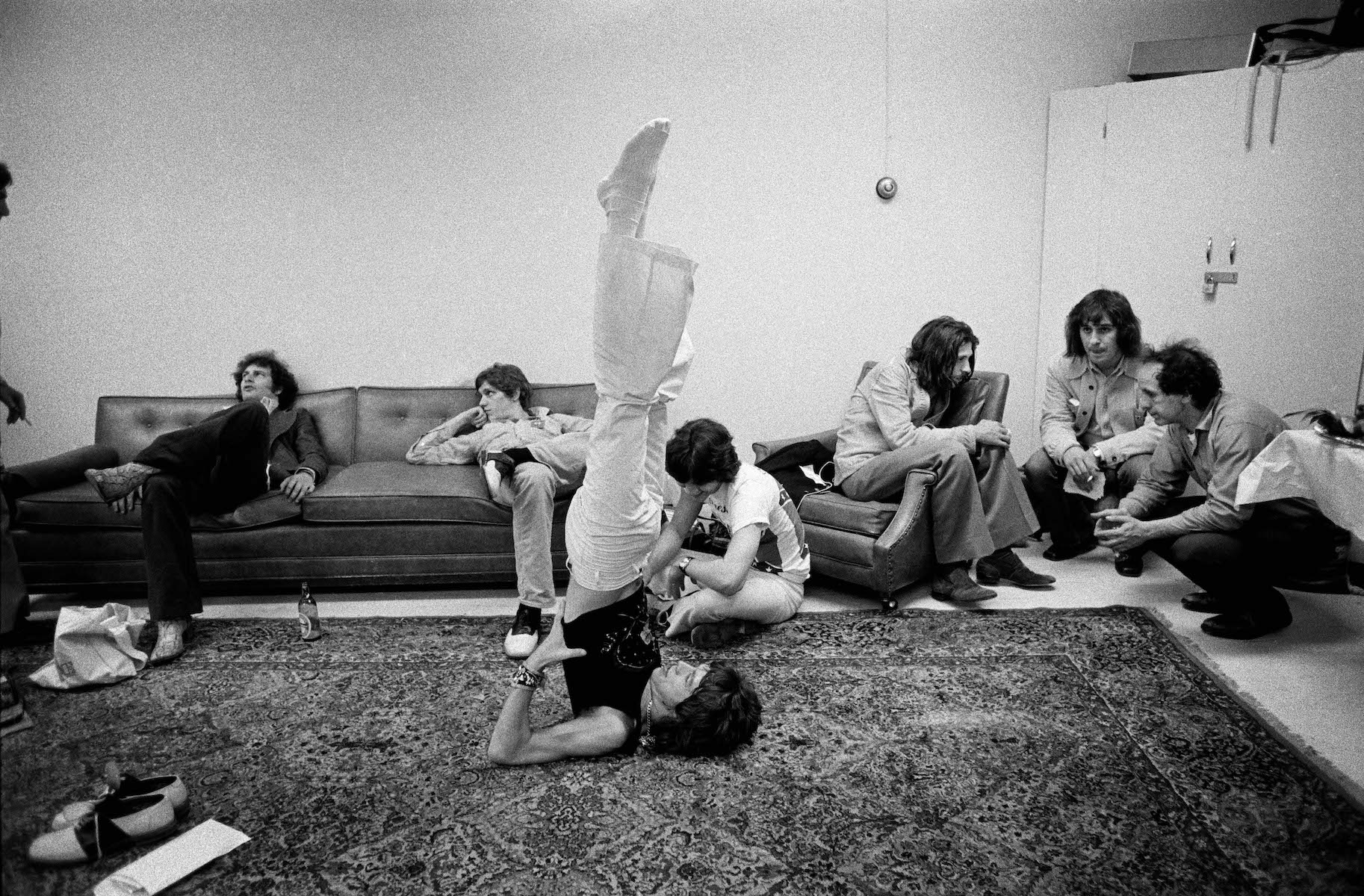Candid photos of the Rolling Stones on tour in 1972
- Text by Miss Rosen
- Photography by Jim Marshall Photography LLC

In 1972, the Rolling Stones had risen to new heights as the bad boys of rock ‘n roll. It was only fitting that their Exile on Main St. tour be documented by a photographer whose reputation matched their own – the legendary Jim Marshall (1936–2016).
“Jim had a reputation,” says Amelia Davis, Marshall’s longtime assistant and owner of the Jim Marshall Estate. Notorious for his love of cars, guns, and drugs – not to mention his take-no-prisoners attitude – Marshall had established himself as the leading music photographer of the times.

Richards, Jagger, Taylor.
After getting his start documenting the San Francisco jazz scene in the late 1950s, Marshall quickly became ensconced with the city’s burgeoning counterculture scene of the 1960s. His iconic photos of everyone from John Coltrane to Jimi Hendrix helped shape ideas about music when it was still a radical force for social change.
But, as Davis notes, more than anything else, Marshall considered himself a photojournalist. When LIFE magazine sent out word they were looking for an official photographer for the Stones tour, Marshall joined the throngs that submitted a portfolio of 10 images hoping for this plum assignment. “For Jim, to get the gig meant the world to him,” says Davis.
To celebrate the 50th anniversary of the historic tour, which became the subject of Robert Frank’s 1979 documentary film, Cocksucker Blues, the Jim Marshall Estate has just released The Rolling Stones 1972 (Chronicle).

Backstage at the Forum, Los Angeles, California. Due to logistics and security concerns, the Stones stayed at the venue between the afternoon and evening shows on June 11

Jagger stretches backstage. To his right, tour manager Peter Rudge huddles with assistant Danny Arnold and Robert Frank
Over the course of the tour, Marshall shot it all, providing an insider’s look at intimate moments in the studio, the banality of backstage, and feverish scenes of the Stones letting loose on stage. Never one to miss out on a good time, Marshall partied along.
“Jim did a shitload of cocaine,” says Davis. “One of the writers from LIFE complained [to the editors] that Jim was doing all this coke and they didn’t know what his photographs were going to look like. But of course, Jim’s photos were amazing. He was able to walk that line with the Stones.”
Although he had all-access, Marshall respected the people he photographed far too much to ever make incriminating or exploitative images that would pass as tabloid fodder. As a result, he earned the band’s trust; they knew they could be themselves without having to worry about being sold out.

Jolie Jones and Keith Richards on the plane back to Los Angeles

Mick Jagger and Keith Richards at Sunset Sound, the LA Recording Sessions, spring 1972
Marshall was far more interested in the Stones as musicians, artists, and men, creating portraits of Mick Jagger, Keith Edwards, Mick Taylor, Charlie Watts, and Bill Wyman that showed more than their bad boy personas.
“There were other photographers on the tour including Annie Leibowitz, Ethan Russell, and Ken Regan, but Jim was the only one to photograph quiet moments like Mick Jagger and Robert Frank on the plane,” says Davis. “Jim had all of these intimate moments among the chaos.”
Looking back at these images, Davis says, “It’s a bygone era. You don’t get that kind of access on stadium tours. You’re never going to see people leaning on the stages and interacting with the band again. It was such a different time.”

Mick Jagger at a publicity photo shoot, spring 1972, Los Angeles, California

LA Recording Sessions

Keith Richards backstage at the Forum, Los Angeles, California

Keith Richards

LARecording Sessions
The Rolling Stones 1972 is out now on Chronicle.
Enjoyed this article? Like Huck on Facebook or follow us on Twitter.
You might like

JayaHadADream: “A lot of us feel the world right now is dystopian”
What Made Me — In this series, we ask artists and rebels about the forces and experiences that shaped who they are. Today, it’s UK rap breakout hotshot JayaHadADream.
Written by: JayaHadADream

In London, rollerskating’s revival rumbles with the city’s soundsystem culture
Rink magic — New quad skate events around the capital are being soundtracked by a cocktail of jungle, dancehall, amapiano, UK rap and more, in a uniquely London fusion. Ian McQuaid reports on the hybrid skate-dances, and the growing pains that the scene has faced.
Written by: Ian McQuaid

Three heart wrenching poems from Gaza
Writings that narrate — With Gaza’s population facing starvation, we are handing over our website to Yahya Alhamarna, a displaced poet and student in Gaza, who shares some of his recent poetry, and explains why writing is so important to him.
Written by: Yahya Alhamarna

Analogue Appreciation: For Those I Love
Carving The Stone — In an ever more digital, online world, we ask our favourite artists about their most cherished pieces of physical culture. Today, it’s post-club producer-songwriter For Those I Love.
Written by: David Balfe aka For Those I Love

Meet Lady Pink, the ‘First Lady’ of graffiti
Miss Subway NYC — As a leading writer and artist in a man’s world, Sandra Fabara has long been a trailblazer for girls in underground art. Now, her new show touches on her legacy, while looking to the future.
Written by: Isaac Muk

Jack Johnson
Letting It All Out — Jack Johnson’s latest record, Sleep Through The Static, is more powerful and thought provoking than his entire back catalogue put together. At its core, two themes stand out: war and the environment. HUCK pays a visit to Jack’s solar-powered Casa Verde, in Los Angeles, to speak about his new album, climate change, politics, family and the beauty of doing things your own way.
Written by: Tim Donnelly

